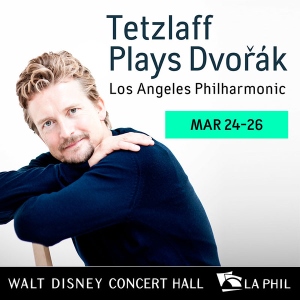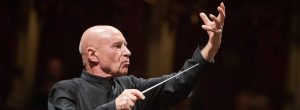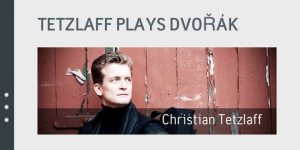TETZLAFF PLAYS DVOŘÁK
There was atmosphere galore in Christian Tetzlaff’s intense interpretation of the Dvořák Violin Concerto last night at Disney Hall, but something was amiss—or rather missing. This is precisely the type of performance that perplexes this critic: Everything is handled right by a soloist, well-steered by conductor, and executed perfectly by well-balanced players. Why, then, doesn’t the piece take off? Guest conductor Christoph Eschenbach had just led the finest orchestra in the land with Dvořák’s Carnival Overture (1891); to say the 10-minute work was rousing is an understatement.
Dvořák wrote this overture as the second in a trilogy of concert overtures, originally titled Nature, Life and Love. Later he changed the names to In Nature’s Realm, Carnival and Othello and gave each its own opus number. Dvořák used the same theme in all three overtures and intended them to be performed together, which is how he conducted them at the premiere. Today, however, only the Carnival Overture remains part of the standard orchestral repertoire.
From the onset, the Los Angeles Philharmonic players exploded with sound, featuring the clanging of the triangle and the rattling tambourine, which captures the frenzied energy of the carnival. This is offset by a slower section, signaled by a blaring French horn, which then subsides into a quiet duet for Denis Bouriakov’s flute and Marion Arthur Kuszyk’s oboe. Without warning, the mad dash of the opening music returns to conclude the overture with a jubilant shout. And the audience followed suit, with a joyous reception.
And while some patrons enthusiastically responded to the Violin Concerto, I wondered if there would be no encore, as the applause was already dying out when Tetzlaff appeared for his first solo bow. Surprisingly, he immediately began playing an impassioned and impeccable “Gavotte en Rondo” from J.S. Bach’s solo violin Partita No. 3 in E major.
But you can’t fool an audience: The Dvořák last night seemed to lack electricity (the program continues through Sunday). Tetzlaff, who—with a large mane of hair tied in a ponytail, looking nothing like his photos—clearly believes in this piece; he plays it often and has even recorded it twice. (I also don’t understand the lack of oomph given Eschenbach’s springy conducting, which is a change from his Germanic leadership of previous programs.) Unfazed by the technical difficulties, Tetzlaff played the piece with powerful peasantry and a rawness that gave the rich outpouring of heartfelt lines a soulful gypsy quality; the German violinist even stomped the ground occasionally during the second movement’s well-known melody. And the last movement, a Slavonic dance in everything but name, had a rhythmic spring and bite that went well beyond merely accomplished violin playing.
Perhaps my reticence is due to the fact that this much loved mainstay of the repertoire is by contrast more conventional in its approach than other violin concertos. Composed 1879–82, the three-movement, fast-slow-fast work relies on thematic and structural patterns established by Beethoven and accepted by Brahms and many others. No fault in that, but even with a bold launch, a meditative middle, a dance-like finale, and first-rate melodies (as are all of this composer’s best works), Dvorák’s heroic and lyric gestures seem slightly shopworn.
I suppose the reason this piece isn’t as popular as the composer’s ubiquitous Cello Concerto is that the many virtuosic passages it forces the soloist to navigate aren’t necessarily the most rewarding musically.
The second half of the program went back to the passion we had with the Carnival Overture. Arnold Schoenberg’s 1937 arrangement of Brahms’ spirited Piano Quartet, Op. 25 (1861), doesn’t really sound like Brahms’ sometimes, and it’s been criticized for this, but I’m grateful that Schoenberg brilliantly orchestrated a major chamber work which too few people would otherwise get to know (to my knowledge, the ubiquitous salons popping up around L.A. in the last decade have not presented this quartet). Escenbach emphasized Schoenberg’s gleaming lushness and breadth (the kind we would expect from Brahms) by indicating a greater sound from an awesome horn section and Joseph Pereira’s timpani. This was a vigorous and attractive 44-minute presentation that carried Brahms’ quartet very well into a new medium.
photos courtesy of LA Phil
Los Angeles Philharmonic
Christoph Eschenbach, Guest Conductor
Christian Tetzlaff, violin
Walt Disney Concert Hall, 111 S. Grand Ave.
ends on March 26, 2017
for tickets, call 323.850.2000 or visit LA Phil




{ 1 comment… read it below or add one }
Great review; spot on for me.